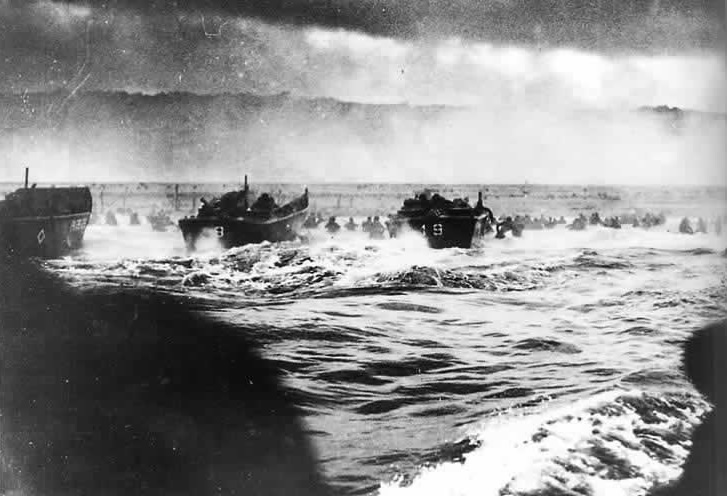My wife Kate is a thirty-year veteran of the Navy, so when we decided to celebrate our wedding anniversary, Paris beckoned. And beyond the City of Light, of course, were the Normandy beaches.
We met our tour guide in the center of the city. Vincent, a slight, neat 41-year old in sharply creased corduroy pants met us and just one other American couple for the ride north. France is so northerly that the winter sun rises after 8 a.m. North through a cold and slashing rain we drove, Vincent keeping up a steady conversation.
We learned that he and his wife had just had their first child. His neighbor, Ahmed, also 41, was welcoming his fifth. Vincent noted out every point of interest along the route and related its story. Included in his recitation was the famous LeMans auto racing track.
It seemed to us he must have honed his skills there because he wove skillfully in and out of the large truck convoys at 85 mph. Launching into his introduction on the Normandy invasion, Vincent was at pains to tell us how clean the French are. “We make the best soaps and perfumes in the world,” he volunteered, “but we had been without them for four years of occupation. And it was a hot summer.” Clearly, Vincent had been stung by unhappy comments by American tourists about the French and their baths.
The rain slackened as we neared the Normandy beaches ahead of schedule. Would it be alright if we stopped briefly at La Cambe, Vincent asked? He quickly explained that this was the German Military Cemetery. We agreed, somewhat reluctantly.
We drove up a winding road lined with kugelbaum. These are trees sculptured to look like inverted pots, a German style we saw nowhere else in France. German families of the dead pay for them, but local French gardeners tend them, we were told. There are some 21,200 German soldiers interred there.
We walked among the graves, noting how many were those of 17- and 18-year olds. Vincent told us of the bus full of German visitors to Normandy. One middle-aged woman came upon her brother’s grave marker. “Please go on and leave me here. You can pick me up on your return,” the grieving sister said.
Every five meters or so, we saw Gothic crosses in gray-purple stone. The rain had stopped but the day was dreary. And the quiet beauty of this well-tended spot filled us with sorrow for the families and their loss. We recognized that many of those here resting were just boys, doubtless draftees.
Kate and I approached the large mound in the middle of the field, topped by three Gothic warriors bearing their shields, back to back. We said a prayer of thanksgiving that our own grandmothers had emigrated to the U.S. from Germany.
From La Cambe, we approached the American Cemetery with a renewed sense of awe. Fewer than 10,000 young Americans are buried here. The row upon row of crisp white crosses are interspersed with Stars of David. The effect is powerful. It is almost as if the multitude are saying: You will have to come through us to get to them. They share a brotherhood of sacrifice.
The American Cemetery is federal property. Those crosses and Stars of David are being challenged all over our country by militants who find any public expression of faith unacceptable. In this time where it seems everything in the past is controversial, will we find renewed attacks on such public memorials?
After La Cambe, the feeling one gets seeing the Stars and Stripes floating over Coleville-sur-Mer is one of exaltation. These soldiers gave their lives in a just cause. President Franklin D. Roosevelt knew when he ordered the men to land in France what the toll might be. The President, speaking from the White House, offered his prayer for the nation that June 6, 1944, saying in part:
Some will never return. Embrace these, Father, and receive them, Thy heroic servants, into Thy kingdom.
And for us at home — fathers, mothers, children, wives, sisters, and brothers of brave men overseas, whose thoughts and prayers are ever with them — help us, Almighty God, to rededicate ourselves in renewed faith in Thee in this hour of great sacrifice.
From the American cemetery, we were driven to Pointe-du-Hoc. There, the large stone dagger memorializes the Rangers who scaled those forbidding cliffs. President Ronald Reagan immortalized those men and their struggle. He termed them “the Boys of Pointe-du-Hoc” and saluted their service as—aged and bent—they sat in reverent silence before him.
Historian Douglas Brinkley has written that it was Reagan who understood the need to highlight the efforts of the few stand for the massed invasion of tens of thousands. Ironically, in Hollywood epics like The Longest Day, the viewer finds it almost impossible to focus on the characters. Their stories seem a blur.
Reagan in his 1984 “Boys of Pointe du Hoc” speech understood what Shakespeare taught us in Henry V.
But pardon, and gentles all,
The flat unraised spirits that have dared
On this unworthy scaffold to bring forth
So great an object: can this cockpit hold
The vasty fields of France?
Descending to the pristine sands of Omaha Beach, we marvel how the French have maintained this area like a holy shrine. Nothing commercial obtrudes. Nothing violates the stillness. In summer, Vincent informs us, there are bathers permitted here. But our soldiers would have fought for them, too.
On this wintry day in 2004, we strain to find some way to note our passage here. No chalk or charcoal to leave “Kilroy was Here” graffiti, even if our boys of ’44 did. Suddenly, Kate decides we will take a small portion of what they fought for. We will scoop up—sand.
When we returned to the U.S., my wife placed that sand in small vials and gave them to her friends, Naval officers retiring. Rarely did we find one who did not tear up on learning where those sands came from. We will always remember Vincent, and the French, but most of all, those white crosses and Stars of David. And that Dagger.
 Robert Morrison served in the U.S. Coast Guard, the Reagan administration, and as a former senior fellow at Family Research Council.
Robert Morrison served in the U.S. Coast Guard, the Reagan administration, and as a former senior fellow at Family Research Council.
No comments yet




